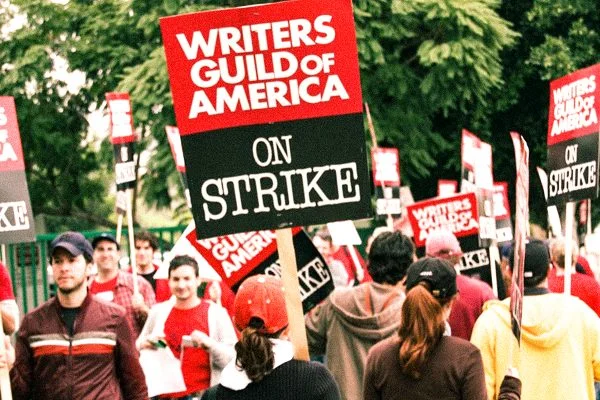After years of frenzied, debt-fuelled investment into on-demand content, the media industry is now facing an almighty crash, with studio staff, creative workers, and streaming customers paying the price. The chaos of capitalism is to blame.
As the crisis of capitalism deepens, art and culture is being throttled by the bosses. To maintain their profits in the face of rising costs, TV studios are making cutbacks and streaming services are continuing to raise their prices. All the while, creative workers are fighting to defend their jobs, pay, and conditions.
From this autumn, the monthly price of a collection of the top streaming services in the US is expected to cost $87 (approximately £69). This is a $14 jump compared to 12 months ago, and $4 more than the average cable TV package.
Netflix, for example, recently removed its cheapest £6.99 ad-free plan in the UK and USA. Ordinary families are now left with the choice of forking out at least £10.99 per month to watch TV without any distractions or breaks, or switching to a budget plan that forces viewers to suffer through dozens of mind-numbing adverts per show.
At the same time, to boost their revenues and ensure healthy profits, media platforms have been cracking down on users sharing their passwords with friends and family if they are not ‘living in a single household’.
Consequently, with the cost-of-living crisis forcing workers to scrimp and save, millions are having to cancel their subscriptions. In Britain last year, paid-for streaming subscriptions fell by two million. Worldwide, Netflix lost almost a million subscribers between April and July of 2022 – the company’s first drop in almost a decade.
Unable to afford or access content legally, many are moving to pirated media. Studios bosses, in turn, have cynically blamed the industry’s demise on those who are consuming TV and film from illicit sources. But the real criminals are the capitalists.
Bubble bursting
Why are these streaming services all raising their prices in tandem? In summary, the industry is facing a classic crisis of overproduction: a direct consequence of the contradictions of capitalism; and another symptom of the instability that is wracking the world economy.
The last decade-and-a-half, until recently, has seen a streaming boom. Netflix led the charge in 2007, transforming its DVD-rental business into an internet-based on-demand video service. Hearing about ‘gold in them thar hills’, other companies – such as Hulu, Apple, Amazon, and Disney – soon followed suit.
It wasn’t long before all the major Hollywood studios were piling in, producing big-budget content directly for streaming.
But all of this was built upon shaky foundations of debt and cheap credit. And now that interest rates are rising and household budgets are tightening, this house of cards (pun intended) is starting to wobble and collapse.
Like every other sector under capitalism, the TV and streaming industry is dominated by a handful of massive monopolies.
Highly-leveraged mergers – such as the recent fusion of WarnerMedia (owner of the HBO network) and Discovery – have led to the formation of powerful media conglomerates that are responsible for the bulk of content production.
Similarly, alongside these giant media monopolies and well-known names like Netflix, Big Tech firms such as Apple and Amazon have come to control the lion’s share of the streaming market.
In their competition for customers and profits, all of these companies have ploughed huge sums of money into producing an abundance of new series and movies. But this has taken place without any plan or oversight, according to the anarchy of the market.
Pandemic lockdowns led to even greater hype and frenzy, with studio and streaming bosses believing that there would be a permanent shift towards TV and on-demand services.
Eyeing up even more juicy profits, the capitalists therefore took on even more debt, and pumped in even more money. Investment in new content jumped by $20 billion in 2021, for example – a 14% increase compared to the previous year.
But with inflation biting and the world economy slowing, the streaming industry boom is beginning to turn to bust. The immense speculation and overinvestment seen in recent years is petering out. And bumper profits are being replaced with massive losses.
WarnerBros has reported that its HBO Max and Discovery+ streaming services are still not profitable, collectively losing $217 million in 2022. Disney, meanwhile, lost an eye-watering $1.05 billion from streaming last year. Only Netflix, the biggest on-demand provider, is currently in the black.
In short, the bubble is starting to burst – not because of piracy, but because of the anarchy of the market.
Cuts and attacks
 Real-terms pay for writer-producers has declined by 23% over the last decade / Image: Eric Appel, Flickr
Real-terms pay for writer-producers has declined by 23% over the last decade / Image: Eric Appel, Flickr
What does this mean for the industry as a whole? It means cuts to jobs and working conditions, price hikes, and other shortcuts – all so that the capitalists can continue to make a pretty penny as the cheap money dries up, interest rates skyrocket, and the accumulated mountain of debts are paid back.
As a result, streaming services are cutting back on the content that they offer. New shows and films that have already been produced are being canned. And even existing series such as HBO’s Westworld are being pulled from platforms.
All of this is a reflection of the madness of capitalism. Despite having already paid millions to make these works, by removing content, the bosses can minimise the amount they pay in tax, while also decreasing the amount they have to pay in residuals to the creative workers who helped produce these series and movies in the first place.
The bill for this crisis is now being presented to the working class. Not only are viewers feeling the pinch to their wallets as streaming prices soar, but workers in the industry are facing attacks across the board. And as fresh commissions dry up, the axe will fall even harder on jobs, pay, and conditions.
Media bosses are already slashing staff as they look to reduce costs and pay off debts. In the wake of its recent merger, for example, WarnerBros-Discovery announced several thousand layoffs – all while increasing bonuses for top executives. Elsewhere, over 7,000 workers at Disney are set to be made redundant. And hundreds of workers at other media conglomerates are also facing unemployment.
According to the Writers Guild of America (WGA), meanwhile, real-terms pay for writer-producers has declined by 23% over the last decade. Similarly, 95% of actors organised in the Screen Actors Guild and American Federation of Television and Radio Artists union (SAG-AFTRA) cannot make a living from acting.
This is the driving force behind the writers’ and actors’ strikes currently raging in Hollywood – a struggle that is only going to intensify as media bosses look to make workers pay for their crisis.
Other creative workers are also beginning to get organised, in order to fight back against dire pay and conditions.
Most recently, two of Disney’s visual effects crews have taken steps to unionise as part of the International Alliance of Theatrical Stage Employees (IATSE). One worker reported having to put in 16-hour shifts, working without any break “from morning until midnight”.
These dog-eat-dog conditions show what happens when culture is commodified, under the ownership and control of the capitalists, with workers and their creativity exploited for profit.
Confines of capitalism
Art and culture should be available and accessible to all. And the digital distribution of TV shows and films should enable this, allowing everyone to enjoy and appreciate great cultural works, past and present.
The move away from cable TV, and towards online streaming, should have meant affordable, on-demand, ad-free access to a wealth of media. In reality, viewers face a mess of disjointed, competing subscription services, each offering different collections of content, with restrictions imposed according to users’ geographical location.
This mess is the result of the insane logic of the market; a product of a chaotic system in which production is for profit, rather than need.
Under capitalism, art and culture will always remain shackled. Within the confines of private ownership, film, television, and music are all turned into mere commodities, churned out to line the pockets of the bosses and shareholders, regardless of quality.
Under socialism, by contrast, the conditions would be created for everyone not only to create art, but also to access and savour it.
The big media and technology companies would be nationalised and put under workers’ control, in order to protect the livelihoods of creative workers, and to open up the platforms, facilities, and resources of these monopolies to the entire working class.
Furthermore, with socialist planning and automation, working hours could be reduced massively, providing the leisure time needed to enable everyone to pursue cultural activities and artistic passions.
On this basis, the full potential of humanity’s creativity could be realised, and art and culture could reach new, untold heights.
To take such a leap, we need to put capitalism and the profit motive into the dustbin of history, where they belong.

